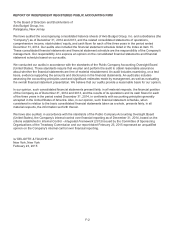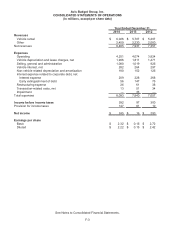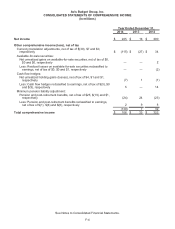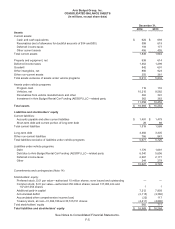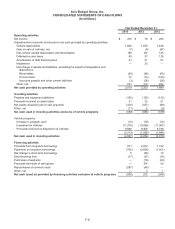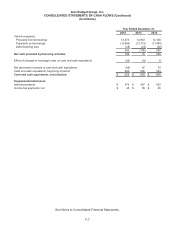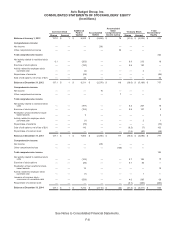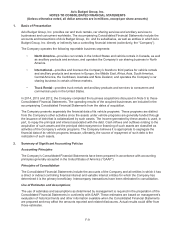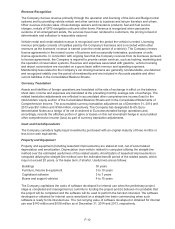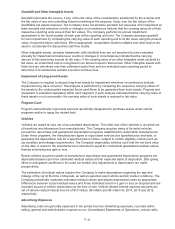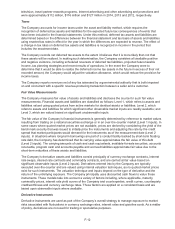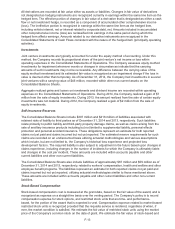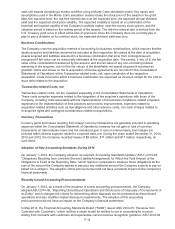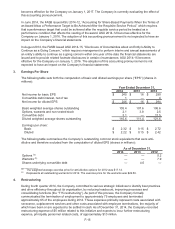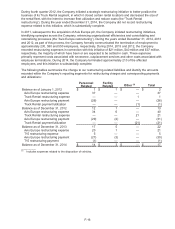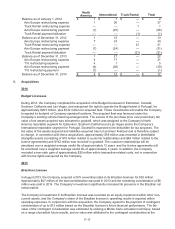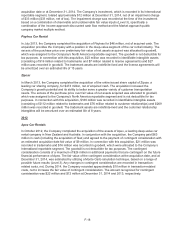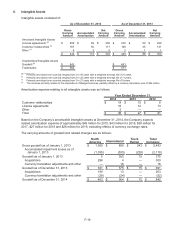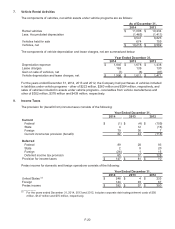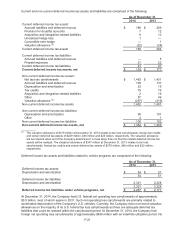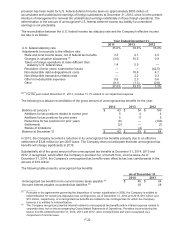Avis 2014 Annual Report Download - page 79
Download and view the complete annual report
Please find page 79 of the 2014 Avis annual report below. You can navigate through the pages in the report by either clicking on the pages listed below, or by using the keyword search tool below to find specific information within the annual report.F-12
television, travel partner rewards programs, Internet advertising and other advertising and promotions and
were approximately $112 million, $116 million and $127 million in 2014, 2013 and 2012, respectively.
Taxes
The Company accounts for income taxes under the asset and liability method, which requires the
recognition of deferred tax assets and liabilities for the expected future tax consequences of events that
have been included in the financial statements. Under this method, deferred tax assets and liabilities are
determined based on the differences between the financial statement and tax basis of assets and liabilities
using enacted tax rates in effect for the year in which the differences are expected to reverse. The effect of
a change in tax rates on deferred tax assets and liabilities is recognized in income in the period that
includes the enactment date.
The Company records net deferred tax assets to the extent it believes that it is more likely than not that
these assets will be realized. In making such determination, the Company considers all available positive
and negative evidence, including scheduled reversals of deferred tax liabilities, projected future taxable
income, tax planning strategies and recent results of operations. In the event the Company were to
determine that it would be able to realize the deferred income tax assets in the future in excess of their net
recorded amount, the Company would adjust the valuation allowance, which would reduce the provision for
income taxes.
The Company reports revenues net of any tax assessed by a governmental authority that is both imposed
on and concurrent with a specific revenue-producing transaction between a seller and a customer.
Fair Value Measurements
The Company measures fair value of assets and liabilities and discloses the source for such fair value
measurements. Financial assets and liabilities are classified as follows: Level 1, which refers to assets and
liabilities valued using quoted prices from active markets for identical assets or liabilities; Level 2, which
refers to assets and liabilities for which significant other observable market inputs are readily available; and
Level 3, which are valued based on significant unobservable inputs.
The fair value of the Company’s financial instruments is generally determined by reference to market values
resulting from trading on a national securities exchange or in an over-the-counter market (Level 1 inputs). In
some cases where quoted market prices are not available, prices are derived by considering the yield of the
benchmark security that was issued to initially price the instruments and adjusting this rate by the credit
spread that market participants would demand for the instruments as of the measurement date (Level 2
inputs). In situations where long-term borrowings are part of a conduit facility backed by short-term floating
rate debt, the Company has determined that its carrying value approximates the fair value of this debt
(Level 2 inputs). The carrying amounts of cash and cash equivalents, available-for-sale securities, accounts
receivable, program cash and accounts payable and accrued liabilities approximate fair value due to the
short-term maturities of these assets and liabilities.
The Company’s derivative assets and liabilities consist principally of currency exchange contracts, interest
rate swaps, interest rate contracts and commodity contracts, and are carried at fair value based on
significant observable inputs (Level 2 inputs). Derivatives entered into by the Company are typically
executed over-the-counter and are valued using internal valuation techniques, as no quoted market prices
exist for such instruments. The valuation technique and inputs depend on the type of derivative and the
nature of the underlying exposure. The Company principally uses discounted cash flows to value these
instruments. These models take into account a variety of factors including, where applicable, maturity,
commodity prices, interest rate yield curves of the Company and counterparties, credit curves, counterparty
creditworthiness and currency exchange rates. These factors are applied on a consistent basis and are
based upon observable inputs where available.
Derivative Instruments
Derivative instruments are used as part of the Company’s overall strategy to manage exposure to market
risks associated with fluctuations in currency exchange rates, interest rates and gasoline costs. As a matter
of policy, derivatives are not used for trading or speculative purposes.


